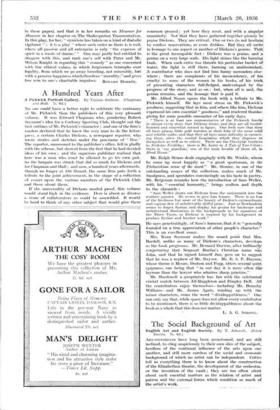The Social Background of Art
English Art and English Society. By T. Ashcroft. (Peter Davies. 7s. 6d.)
ART-HISTORIANS have long been accustomed, and arc still inclined, to cling suspiciously to their own slice of the subject: heedless of the continual influence of the arts upon one another, and still more careless of the social and economic background of which no artist can be independent. Critics tell us everything there is to know about the construction of the Elizabethan theatre, the development of the orchestra, or the invention of the vault ; they are too often silent about such essential matters as the relation of artist and patron and the external forces which condition so much of the artist's work.
But there are signs of a reversal of critical policy, and- in Mr. Asheroft:s little book we have a comprehensive attempt at a sociological interpretation of English art:, briefly covering the development of English literature, _Painting and architecture from 1660 to 1914. The limits of date are ,not so arbitrary as they at 'first appear, for the -author regards the period he has chosen as exemplifying the rise, triumph and " manifest crisis " of bourgeois power in every part of the social edifice, and naturally in art also, its "topmost storey." Here then is a comparative history of English art from the severely Marxian standpoint, frequently suggestive and even illuminating in detail and perspective, but marred by some failure on the author's part to live up to a passage on his. last page which draws attention to " the remoteness, relatively speaking, of art from the economic foundations " and the danger of attempting to " over-simplify the theory of Historical Materialism and take easy but quite unjustified short-cuts from economic conditions to mental and aesthetic reflections." Such problems are indeed well worthy of study : what, for instance, is the relation between the inner compulsion of the artist, the economic compulsion of his surroundings, and the art-tradition in which he works ? How far are they reconciled in Velasquez, in Mozart, in Swift ? But work of this sort demands not only wide historical knowledge but the rarest qualities of insight and discrimination, and Mr. Ashcroft's method -of starting off with an honest hypothesis and making everything fit it is too rough a tool for the job.
It is probably true that no theory could have been more illuminating or more apt than that to which he subscribes : again and again, especially towards the end of the book, the er;tical value of this approach to art is demonstrated. But he suffers front a desperate desire to make everything fit. Even economists are beginning to fear (what the world has long suspected) that in no system can everything be made to fit ; and what is true of economics is far more true of the intimate spiritual creations of the artist. Is it, for example, really helpful to align the heroic couplet and the sonata on the
ground that both- " exalt the -formal at the expense of the adventurous and emotional " ? One assents to the implied contrast with Elizabethan blank verse ; but the sonata was preceded by the far more formal fugue and sqite. There is some absurdity too, in the attempt to relate the growth 'of nature-poetry in the eighteenth century to the interest of industrial capitalism in the " study and ,utilisation of the properties of all the different natural resources " ; and to find in the development of " declamatory solos and arias instead of polyphony, the exaltation of the individual impresario (sic) over the massed and equalitarian work of choral music " an analogy with the monotonous piece-work which superseded mediaeval craftsmanship.
One of the difficulties of this sort of comparative criticism is that it demands a deep and equal sensitiveness to all the arts which few possess, and without which gaps must be
filled in by mere condensation from works of reference. From the evidence of his book I should suppose Mr. Ashcroft to be primarily interested in painting, architecture and prose, much less in poetry, and very little in music. It is odd to find Swinburne praised for his " fine rationalistic poetry," Hardy for his " direct and pellucidly clear English," and Browning
as the greatest creator of character in English literature after Shakespeare." And how insensitive the author seems to the peculiar quality of Keats' melancholy :
When wo consider how often,- in the nineteenth century, the same note of pessimism is sounded, it is evident that the cause must be traced to no individual source. It is, on the contrary, to be found in the contrast between human possibilities and human actualities—a cause which is itself the result of the social contra. diction between the over-growing powers of production and the incapacity of man to control these powers in the general interest. Keats, an outspoken radical, felt these things intensely.
The fact, which Mr. Ashcroft will not face, is that the currents of literature and art sometimes flow with the social and economic stream and sometimes cut clean across it in obedience to their own internal rhythms and the multitude of unpredictable whirls and eddies of individual genius. An absorbing book might result from an attempt to plot the relationship over a given period, rigidly excluding all forced analogies. Mr. Ashcroft has chosen a less arduous task, but his conspectus of English art, provided that one cocks a
critical eye at his over-tidy classifications and parallels, contains a great deal that is both stimulating and true.
DESMOND &UWE-TAYLOR.



































































 Previous page
Previous page